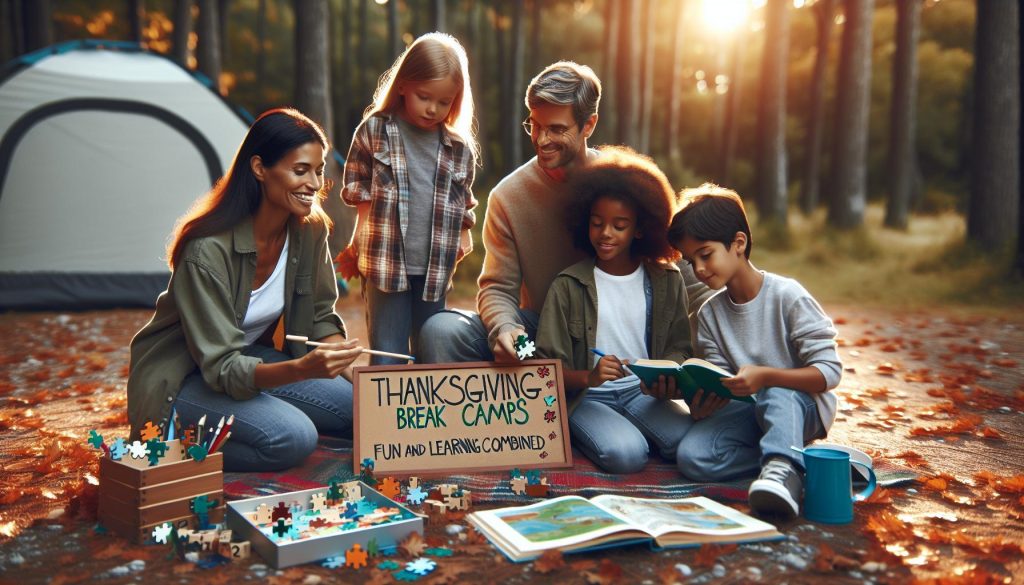Thanksgiving Break Camps for Kids: Fun adn Learning Combined
As the leaves turn golden and the scent of pumpkin spice fills the air, parents everywhere face the annual challenge: how to keep the kids engaged during Thanksgiving break without losing their sanity—or the last slice of pie! Enter Thanksgiving Break Camps for Kids: Fun and Learning Combined! These camps are like a turkey feast for the mind, mixing the deliciously entertaining with the wonderfully educational.Picture your kids diving into exciting projects, embarking on creative adventures, and maybe even learning a thing or two—while you enjoy a well-deserved moment of peace and quiet. Forget the usual screen time battles; this is where kids can unleash their inventiveness, develop new skills, and make friends that will last beyond this holiday season. So gather ‘round, don your best chef’s apron, and let’s explore how these camps can serve up a heaping helping of fun and learning that everyone will be thankful for!
Understanding the Importance of Thanksgiving Break Camps for Kids
Thanksgiving break camps offer children a unique prospect to engage in a variety of enriching activities while taking a break from traditional school routines. These camps are not just about keeping kids occupied; they provide a structured environment where children can thrive both socially and intellectually. Emphasizing hands-on learning, these programs frequently enough blend play with education, encouraging creativity and teamwork.
During this festive season, camps focus on themes that align with the spirit of Thanksgiving, such as gratitude, community service, and cultural thankfulness. Activities might include:
- Arts and Crafts: Kids can create handmade decorations or gifts that embody the Thanksgiving spirit.
- Cooking Classes: Children learn to prepare simple dishes, giving them a taste of culinary skills while fostering a love for cooking.
- Nature Walks: Exploring local parks helps kids understand the importance of nature and encourages physical activity.
- Community Service Projects: Participation in helping others teaches valuable lessons about empathy and giving back.
Moreover, Thanksgiving camps provide parents with peace of mind by offering a safe and supervised environment during the holiday break. These camps not only stimulate learning but also help children develop vital social skills. They get the chance to interact with peers, solve problems collaboratively, and build friendships—an essential aspect of childhood advancement.
| Benefits of Thanksgiving camps | examples of Activities |
|---|---|
| Fosters Independence | Individual projects and group challenges |
| Enhances Learning | Interactive workshops and educational games |
| Promotes Physical Activity | Outdoor games and sports |
| Encourages Community Values | Fundraising and volunteering initiatives |
Exploring Diverse Activities: From Arts and Crafts to Science Experiments
During the Thanksgiving break, kids are offered a unique opportunity to immerse themselves in a world of creativity and discovery.From arts and crafts to engaging science experiments, these camps provide a rich blend of activities that stimulate both the mind and the senses. Children can express their artistic side while also delving into the engaging realm of STEM (Science, Technology, Engineering, and Mathematics).
Participants can look forward to a variety of hands-on experiences, such as:
- Art Workshops: Create beautiful Thanksgiving-themed art pieces using paints, clay, and natural materials.
- Crafting Sessions: Design handmade decorations or gifts that kids can take home to share their holiday spirit with family.
- Science Explorations: Conduct simple yet exciting experiments, like making slime or creating volcanoes, while learning the basic principles behind these phenomena.
- Culinary Activities: Get involved in cooking sessions, where children can prepare festive snacks and learn about nutrition and cooking techniques.
Here’s a simple overview of some common camp activities that blend fun with educational elements:
| Activity Type | Key Learning Outcome |
|---|---|
| Arts and Crafts | Enhances creativity and fine motor skills |
| Science Experiments | Fosters curiosity and critical thinking |
| Outdoor Activities | promotes teamwork and physical fitness |
| Culinary Workshops | Teaches healthy eating habits and basic cooking |
thanksgiving break camps are more than just a way for kids to pass the time; they’re a chance to learn, grow, and create lasting memories. Kids leave these camps not only with new skills and knowledge but also with the joy of having collaborated with peers in a dynamic environment.
Boosting Social Skills: How Camps Foster friendships and Teamwork
Camps during the Thanksgiving break offer a unique environment where children can thrive socially and develop essential interpersonal skills. By immersing themselves in team-based activities and collaborative projects, kids not only have fun but also learn valuable lessons in dialog, cooperation, and problem-solving.
Key components that contribute to the development of social skills at these camps include:
- diverse Interactions: Camps attract kids from various backgrounds, providing opportunities to make friends outside of their usual circles.
- Team Activities: engaging in group tasks, such as team sports or collaborative art projects, encourages children to work together and fosters a sense of belonging.
- Conflict Resolution: Navigating disagreements or differing opinions in a camp setting teaches kids how to resolve conflicts constructively.
- Communication Skills: Regular interactions with peers help improve listening and speaking abilities, as children learn to express themselves clearly and confidently.
Structured activities and group dynamics play a pivotal role in strengthening friendships and enhancing teamwork skills. Many camps incorporate specific programs designed to build these capabilities. Consider the following popular types of group exercises:
| Activity Type | description | Social Skills Developed |
|---|---|---|
| Team Sports | Engaging in games such as soccer or basketball | Collaboration,Leadership,Communication |
| Group Challenges | Solve puzzles or complete obstacle courses as a team | Problem-Solving,Trust-Building,strategy |
| Creative Workshops | Collaborating on art projects or performances | Creativity,Empathy,Versatility |
By the end of their camp experience,children leave with not just unforgettable memories but also a stronger foundation for future interactions in school and beyond. The friendships formed and teamwork practiced are invaluable tools that will benefit them in every aspect of their lives.
Choosing the Right Camp: Key Considerations for Parents
When selecting a camp for your child during the Thanksgiving break, several vital factors shoudl guide your decision. A well-suited camp not only offers engaging activities but also fosters a safe and nurturing environment. Here are some critical aspects to consider:
- Age Appropriateness: Ensure that the camp caters to your child’s specific age group, as different ages will have distinct interests and needs.
- Curriculum Focus: Look for camps that combine fun with learning. Check if they offer educational themes, like STEM, arts and crafts, or outdoor exploration, that align with your child’s interests.
- Location: Consider the convenience of the camp’s location. Is it close to your home or workplace? A short commute will reduce stress for both you and your child.
- Staff Qualifications: Investigate the background of camp leaders and counselors. Qualified,experienced staff can significantly impact your child’s safety and enjoyment.
Additionally, consider practical aspects such as the camp’s schedule, fees, and available flexibility for pick-up and drop-off times.Some camps may offer extended hours to accommodate working parents, which can be invaluable during the holiday season.
| Consideration | Details |
|---|---|
| Age Range | 5-12 years |
| Location | Local community centers, schools |
| Typical Activities | arts & crafts, sports, nature walks |
| Cost | Varies, averaging $200-$400 per week |
| Camp Duration | 1 week (Thanksgiving break) |
Lastly, don’t underestimate the value of asking your child for their input. A camp that excites your child will lead to a more enriching experience. Trust their instincts; after all, they are the ones who will be engaging in the activities. By thoroughly considering these factors,you’ll be better equipped to select a camp that not only safeguards your child’s well-being but also enriches their holiday experience with fun and learning.
Safety Measures and Health Protocols in Holiday Camps
Ensuring the well-being of children during holiday camps is paramount.Camp organizers are adopting extensive safety measures and health protocols to create a safe environment. Here are some of the key protocols being implemented:
- Health Screening: Daily health screenings including temperature checks and symptom assessments are conducted prior to camp activities to identify any illnesses early.
- Hygiene Practices: Regular handwashing and the provision of hand sanitizers at various stations throughout the camp help to prevent the spread of germs.
- Small Group Sizes: To minimize exposure, children are placed in small, stable groups, limiting the number of contacts each child has throughout the day.
- Mask Mandates: Depending on local health guidelines, masks might potentially be required, especially in indoor settings or during group activities.
- Enhanced Cleaning Protocols: Common areas and frequently touched surfaces are cleaned and disinfected frequently to ensure a hygienic environment.
A chart summarizing the key health protocols may include:
| Protocol | Frequency |
|---|---|
| health Screening | Daily |
| Handwashing | Before & After Meals, After Activities |
| Cleaning Disinfectants Used | Multiple Times a Day |
| Mask Wearing | As per Health Guidelines |
These measures not only prioritize the safety of participants but also aim to instill a sense of security in parents. With these protocols in place, parents can feel confident that their children are engaging in enjoyable, educational activities while prioritizing their health and safety.
Integrating Learning with Fun: Educational Outcomes from Camp Programs
During Thanksgiving break, camps designed for kids become a rich tapestry of learning interwoven with fun.These programs foster an environment where education transforms into an engaging adventure, encouraging children to explore new interests and develop essential skills. From STEM projects to arts and crafts, the variety of activities helps kids absorb knowledge while igniting their creativity and enhancing social skills.
The integration of educational components in camp activities is often reflected through:
- Hands-on Learning: Children engage in experiments, craft-making, and team challenges that require problem-solving and critical thinking.
- Interactive workshops: Many camps offer sessions led by educators and professionals, exposing kids to expertise in fields such as science, technology, engineering, and the arts.
- Social Development: Group activities help build teamwork and leadership skills, essential for personal and academic growth.
- Cultural Appreciation: Camps frequently enough guide kids to explore diverse traditions and practices during the Thanksgiving season, broadening their worldviews.
To quantify this impact,consider the following table showcasing the expected educational outcomes from typical camp programs during the Thanksgiving break:
| Activity Type | Learning Outcomes | Skills Developed |
|---|---|---|
| STEM Activities | Understanding scientific principles | Problem-solving,analytical thinking |
| Arts and Crafts | Cultural expression and creativity | Fine motor skills,visual-spatial awareness |
| Team Sports | Rules of cooperation and strategy | Teamwork,leadership |
| Culinary Workshops | Nutrition and cooking basics | Math skills (measuring),teamwork |
ultimately,Thanksgiving break camps blend learning and fun,providing children with invaluable experiences that extend beyond the classroom. Camps not only nurture knowledge but also empower kids to express themselves, build lasting friendships, and develop a lifelong love of learning.
Testimonials from Parents and Kids: Real Experiences That Matter
At our Thanksgiving Break Camps, we pride ourselves on creating enriching experiences for kids, and the feedback we receive serves as a testament to that commitment. Here’s what some parents and kids have to say about their time with us:
Parent Testimonials
- Susan M. shared, “My daughter came home every day excited to tell us about the new skills she was learning. The combination of fun and learning really kept her engaged!”
- James K. commented, “The facilitators were fantastic! They created an environment that was not only safe but also encouraged creativity and teamwork among the kids.”
- Linda T. noted, “I appreciated the variety of activities offered. It’s hard to find programs that cater to both my child’s interest in arts and science, but this camp managed to do just that!”
Kid Experiences
- Jake, age 10, exclaimed, “I loved the cooking class! I learned how to make pumpkin pie, and now I can help my mom in the kitchen!”
- Sofia, age 12, shared, “The science experiments were my favorite! We made volcanoes and learned about chemical reactions. It was super cool!”
- Leo, age 9, stated, “The sports activities were the best! I made new friends and even tried out soccer for the first time. Can’t wait to come back next year!”
Summary of Feedback
| Aspect | Parent Feedback | Kid Feedback |
|---|---|---|
| Learning Opportunities | Highly rated for diversity and engagement | Fun and interactive activities |
| Staff Quality | Experienced and encouraging | Friendly and approachable |
| Activity Variety | Balance of arts and sciences | Exciting and adventurous |
Q&A
What types of activities can children expect at Thanksgiving break camps?
Thanksgiving break camps for kids typically blend a variety of educational and recreational activities. These camps are designed to engage children in fun, hands-on experiences while balancing learning components. activities frequently enough include arts and crafts, sports, cooking, science experiments, and outdoor games. For example, camps may introduce themes related to the Thanksgiving holiday, where children create decorations, engage in team-building exercises, or learn about gratitude through interactive storytelling sessions.
In addition to traditional activities,many camps emphasize STEM (Science,Technology,Engineering,and Mathematics) learning. Children might participate in coding workshops or engineering challenges, which encourage problem-solving and creativity. Research indicates that engaging children in such hands-on learning during break periods can help reinforce classroom lessons and stimulate their interest in learning. According to the National Summer Learning Association, structured break camps can prevent learning loss, which is crucial especially during extended holidays.
How are Thanksgiving break camps structured to balance fun and learning?
Thanksgiving break camps frequently enough adopt a thematic approach that seamlessly integrates fun with educational objectives.Each day may be centered around a specific theme, allowing for a cohesive learning experience. As a notable example,one day might be dedicated to “science and nature,” where kids explore the biology of turkeys,while the next could focus on “cultural appreciation,” teaching children about the history of Thanksgiving and traditions from various cultures.
The schedule typically divides the day into blocks that allocate time for both structured learning and free play.This can include:
- Morning activities that introduce educational games or workshops.
- Afternoon sessions filled with recreational sports or creativity-focused crafts.
- Group discussions or reflection time, allowing kids to share what they learned and how they applied it creatively.
This structure not only helps maintain children’s interest but also ensures that they engage both cognitively and socially, fostering teamwork and communication skills.
Who can benefit from attending Thanksgiving break camps?
Thanksgiving break camps cater to a diverse range of children, typically from ages 5 to 14.These camps are notably beneficial for children who thrive in social settings, as they provide opportunities to meet peers and build friendships. For many youngsters, being away from home and participating in group activities can enhance social skills and boost emotional intelligence.
Moreover, children who might potentially be experiencing learning gaps or challenges can greatly benefit from the focused, supportive environment that break camps offer. By emphasizing skill-building through fun activities, camps can help reinforce academic concepts in an engaging way. Studies suggest that children who participate in structured camps during breaks show improved attitudes toward learning and increased confidence in their abilities. Their enthusiasm can translate into a more positive school experience when they return.
How can parents choose the right Thanksgiving break camp for their children?
Selecting an appropriate Thanksgiving break camp involves considering several factors to ensure a good fit for your child.Firstly, parents should assess their child’s interests and needs. If a child enjoys science and nature, a camp focused on environmental education or wildlife might potentially be ideal. Alternatively, for kids who love arts, a camp centered around crafts and performances might be more appealing.
Budget is another essential consideration. Many camps offer different pricing tiers based on features, duration, and included meals. Parents should inquire about any available scholarships or financial assistance,which can make participation more feasible for families on a tighter budget.
Lastly, evaluating the camp’s staff qualifications and safety protocols is crucial. Parents should look for camps that have trained personnel, clear safety guidelines, and positive reviews or recommendations from other families. Any camp that emphasizes open communication with parents about daily activities and children’s well-being is usually a good sign of a trusted program.
What are the potential benefits of Thanksgiving break camps for social development?
Thanksgiving break camps offer numerous advantages for social development among children. One key benefit is the opportunity for children to cultivate social skills through interactions with peers.The collaborative nature of planned activities encourages teamwork and cooperation, helping kids learn how to communicate effectively, resolve conflicts, and share responsibilities. These experiences can enhance their ability to navigate various social settings, a crucial skill for childhood and beyond.
Moreover, these camps frequently enough foster a sense of community and belonging. When children participate in group challenges or creative projects,they naturally bond with one another,strengthening friendships and support networks. According to the American Camp Association, children who attend camps report higher levels of confidence and stronger relationships with peers as they feel they are part of a community where everyone is working towards common goals while enjoying themselves.
Lastly, navigating different social dynamics, such as making new friends or dealing with peer pressure, can significantly contribute to a child’s personal growth.Exposure to diverse groups and backgrounds enables children to develop empathy and understanding, qualities that are invaluable as they grow and interact in various environments throughout life.
Are Thanksgiving break camps only offered in person, or are there virtual options available?
While many Thanksgiving break camps are held in-person, there is an increasing number of virtual options available, particularly following the rise of online education during the pandemic. Virtual camps can be appealing to families who prefer the flexibility of staying home or those who may not have local options that suit their child’s needs. These camps utilize online platforms to engage children in a wide range of activities, including interactive crafts, live tutorials, and even virtual field trips.Online camps frequently enough provide comprehensive schedules that mirror traditional camp experiences, allowing kids to participate in various sessions over the break. Activities might include live cooking classes, coding boot camps, or themed workshops focused on Thanksgiving traditions from around the globe. Moreover, many virtual camps encourage children to interact with their peers through breakout sessions or group projects, fostering socialization even in an online environment.
Though,as with any camp option,it’s essential for parents to review the curriculum and format of virtual camps. Effective online programs will include engaging content and experienced instructors who can manage virtual interactions and keep children motivated and involved. As reported by parents from such camps, the flexibility and accessibility of virtual formats have opened up opportunities for many children to engage in learning and fun despite geographical constraints.
In Summary
As we’ve explored, Thanksgiving break camps offer a fantastic opportunity for kids to blend fun and learning in a memorable way. With activities ranging from arts and crafts to science experiments and outdoor adventures,these camps are designed to keep young minds engaged while providing a much-needed break from the classroom. The benefits extend beyond just enjoyment; the socialization, teamwork, and skill-building that occur during this time can have lasting impacts on children’s development.
Whether you’re considering enrolling your child in a local camp or looking for programs that emphasize specific learning goals, the options are abundant. remember to research thoroughly and choose a camp that aligns with your child’s interests and needs. With the right program, this Thanksgiving break can be a perfect combination of joy, exploration, and growth. So as you plan for the holidays, keep in mind the enriching experiences that camps can provide. Here’s to a season of gratitude, joy, and learning!




